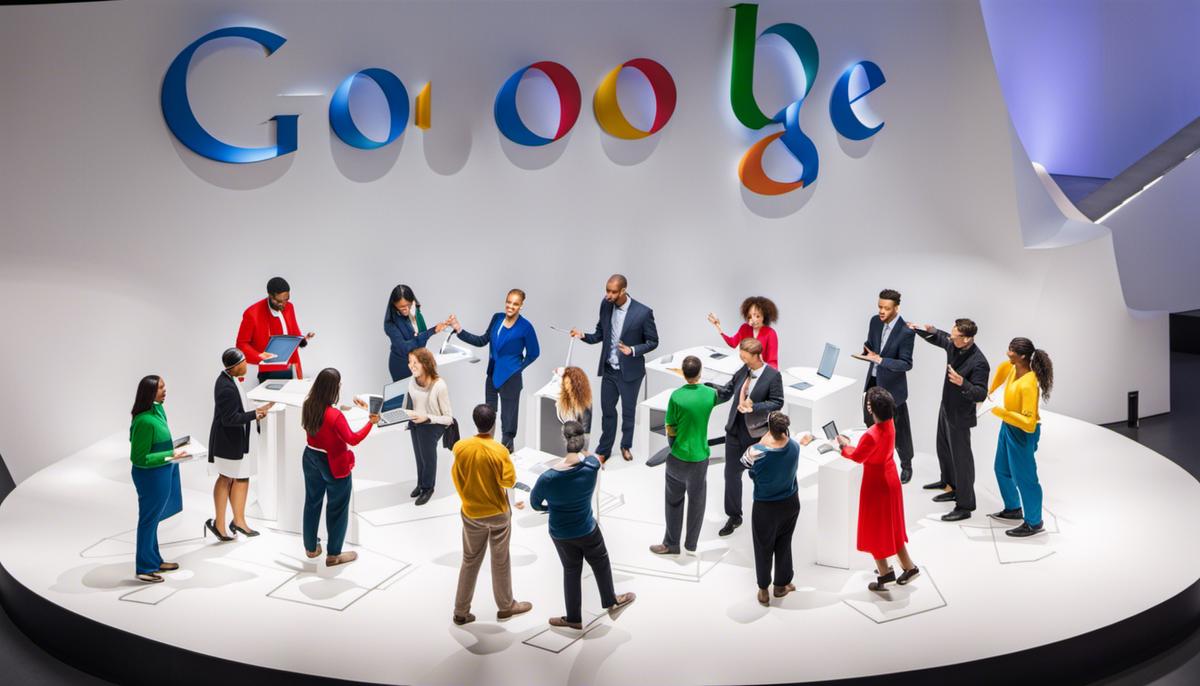In the dynamic and competitive world of business, every professional with a desire to excel should aim to understand the leadership strategies and practices that have catapulted global corporations to the pinnacle of success. Among such companies, Google stands out as an intriguing case study, thanks to its monumental rise to become one of the most influential and innovative organizations in the world. This piece unravels the unique characteristics of Google’s leadership style, its emphasis on creativity and innovation, the value it places on transparency and open communication, its reliance on data-driven decision making, and the steps it takes in fostering a positive and inclusive work culture. Synthesizing these insights will provide a rich understanding of the leadership lessons that can be gleaned from Google’s operational blueprint.
Google’s Unique Leadership Style
At Google, Leadership is not merely the responsibility of those at the upper echelons of the hierarchy. Instead, the company promotes a team-oriented approach where leadership is often distributed among team members based on their expertise or interest. This collaborative environment fosters innovative thinking and allows for a wealth of diverse perspectives to be brought to the table.A key standout of Google’s leadership style is its flat corporate structure. Notably less hierarchical than many other corporate giants, Google values the input of each member of their vast workforce. Employees are encouraged to take the initiative, make decisions, and take ownership of their projects. This flat structure has essentially blurred the lines of traditional corporate ladder climbing, made the company more agile and capable of making swift decisions, and also provides staff members with a sense of empowerment.Google places a remarkably high emphasis on innovation. From the beginning, the company has sought to innovate, not merely to compete. To facilitate ongoing creativity and out-of-the-box thinking, Google allows their engineers to spend 20% of their time on personal projects, a practice widely known as the 20% time policy. This underscores the company’s unwavering commitment to innovation through employee freedom.Google’s team-oriented approach and flat organizational structure promote a great deal of employee autonomy and freedom. As a result, employees are motivated and they feel a greater sense of ownership over their work. The company believes that by giving its employees freedom, they will be more innovative, happier, and ultimately, more productive. This has proven to be an effective approach, as it has led to some of Google’s most successful projects, such as Gmail, Google News, and Adsense.A key business leadership lesson from Google’s distinctive leadership style is their unyielding commitment to pushing boundaries. Google is unafraid to take calculated risks or push its people to strive for goals that seem unattainable. They encourage employees to shoot for the moon, and even if they fail, they’ll still be among the stars. This mindset has ultimately defined Google’s leadership style and organizational culture.Google’s leadership places a high value on collaborative creativity. The company emphasizes the importance of teamwork and collaborative problem solving to cultivate an innovative and productive working environment. Employees are encouraged to work together, exchange ideas, and build upon each other’s contributions. This approach has led to the development of many ground-breaking products and technologies throughout Google’s history.To sum up, Google’s noteworthy leadership approach that cultivates team collaboration, appreciates employee freedom, favours flat organizational structure, and persistently propels the frontiers of innovation, provides meaningful lessons for leaders in several business sectors. These industries can look to create a vibrant and open setting that promotes taking risks while appreciating the contribution of each team member. In doing so, it can lead to revolutionary outputs and an energized workforce.

Emphasis on Innovation and Creativity
Crucial to Google: Innovation and Creativity
The central pillar of Google’s corporate ethos is their unyielding commitment to innovation and creativity. This greatly moulds their norms and procedures, setting them apart from other corporations that mainly rely on conventional and tried-and-true operational procedures. Google’s effort to constantly chart new waters has led to a standout office setting that amplifies creativity and spurs technological progression. Businesses eager to learn from Google’s style can employ comparable strategies to foster out-of-the-box thinking which could lead to major market explorations.
The ’20 Percent Time’ Policy
One of the most famous policies Google has implemented to foster creativity among its employees is the ’20 percent time’ policy. The policy, unofficial yet popular, allows Google’s engineers and product developers to spend one-fifth of their working hours on projects that aren’t necessarily related to their main job scope. This concept provides employees with the freedom to explore creative ideas and projects that spark their personal interest. This policy has positively impacted Google, resulting in some of its most successful products such as Gmail and Google News, thereby demonstrating the power of creative freedom.
Open Work Spaces: Encouraging Collaboration and Exchange of Ideas
Google’s physical work spaces are deliberately designed to inspire creativity and innovation. The company’s headquarters, known as the ‘Googleplex’, is both colorful and informal, with open spaces that foster collaboration and encourage the exchange of ideas. Comfortable lounges, cafes, gaming areas, and mini libraries enhance an environment where employees can relax, brainstorm, and come up with creative solutions to complex problems. This design principle can be implemented in other businesses to create a vibrant and active work environment that spurs innovative thought.
Regular Brainstorming Sessions: The Power of Diverse Ideas
Google promotes innovation through regular brainstorming sessions known as ‘Tech Talks’. During these sessions, experts share their knowledge on a variety of subject matters. This platform encourages employees to learn, discuss, and generate creative ideas. The value of pooling diverse ideas in a collaborative setting aids in problem-solving and fosters innovation.
Google’s Perseverance with Innovation
The philosophy ‘Innovation, not instant perfection’ motivates Google’s activities. This mantra encourages the launch of beta products followed by iterations based on user feedback. This agile development process cultivates a culture of continuous improvement, pushing for constant innovation rather than a one-time perfect solution.
Google’s Creative Training Program
Google also incorporates creativity into its training program, Google’s Creativity Skills for Innovation Lab. This program designed to help employees become more innovative by equipping them with the knowledge and techniques they need to unlock their creativity. Businesses can devise similar programs to stimulate employees’ innovative potential and creativity.
Embracing the principles that underpin Google’s leadership lessons is integral to companies that desire to cultivate a culture that is conducive to innovation, encourages creativity, and views failure as an essential path to success. Approaches such as Google’s renowned ’20 percent time’ policy, encouraging open work spaces, and routinely scheduling brainstorm sessions can significantly propel a business towards its full capacity for creativity and innovation.

The Importance of Transparency and Open Communication
Embracing an Open Communication Culture at Google
Google’s unique approach to business leadership involves a significant emphasis on transparency and open communication, a modus operandi that has been paramount in establishing trust amongst its employees and promoting innovation. This culture also encourages a strong sense of accountability, a feature that distinguishes Google as one of the most successful companies globally.
Utilizing Open Forums
One of the ways Google fosters transparency is through open forums known as ‘TGIF’ (Thank God It’s Friday) meetings. During these sessions, co-founders Larry Page and Sergey Brin, along with CEO Sundar Pichai, openly discuss company performance, upcoming projects, and even address employee concerns and questions. This platform encourages every employee, regardless of their role or position, to engage in direct communication with the top leadership. These sessions augment mutual trust and establish an open culture where everyone feels valued and heard.
Emphasizing Regular Feedback
Google also encourages a feedback-oriented culture. They utilize various methods to collect feedback, such as upward feedback surveys, where employees assess their managers’ performance, and “Googlegeist,” a company-wide survey to gauge employees’ feelings on a range of topics. This emphasis on regular feedback ensures that everyone’s perspectives are acknowledged, fostering a sense of inclusivity. It also enables leaders to identify and rectify areas needing improvement, leading to increased efficiency and job satisfaction among employees.
Direct Communication
Another cornerstone of Google’s leadership framework is direct communication. Leaders at Google maintain open lines of communication with their teams, ensuring everyone has a clear understanding of their roles, the company’s goals, and how they align. This practice not only aids in removing ambiguity but also in fostering a culture of collective responsibility.
Trust and Accountability
Through its culture of transparency and open communication, Google cultivates a unique sense of trust among its staff, facilitating a conducive work environment that bolsters productivity. Moreover, it promotes heightened accountability as employees feel more invested in their work when they understand its impact on the organization’s overall goals.
Google’s Leadership Lessons
When it comes to expanding innovation and facilitating growth, the leadership principles that Google espouses offer an enlightening cache of lessons for businesses. Open forums, routine feedback, and forthright communication form the baseline of Google’s culture, aiming at creating an environment where employees feel seen, heard, and therefore valuable. These strategies propel morale, heighten productivity, and induce a feeling of collective accountability. Notably, the emphasis on transparency and open dialogue cultivates trust, as well as credibility among the employees. This respect within the workforce significantly fuels the growth and eventual success of a company.

Data-Driven Decision Making in Google
The Data-Centric Philosophy of Google
Google’s philosophy thrives on simplicity: Let data guide all decisions. This data-anchored principle extends from day-to-day tasks to the strategic planning of ambitious blueprints. It is this philosophy that has not only catalyzed Google’s transformative growth and success but has also instilled within the organization an inherent flexibility and adaptability, which are key to fostering diversity.
Data Analysis in Google’s Management
Google’s management relies on data analysis as a central tool that directs its decision-making process. This starts from the recruitment process where Google collects and analyzes large datasets about applicants to select the most qualified candidates, and continues in decisions about promoting and rewarding staff. Google uses data analysis to set, track, and meet key performance indicators, constructing employee feedback, and making decisions regarding human resources.
In project management, Google uses data to formulate strategies and make critical decisions. Data metrics help the company understand if a project is on track or if it needs adjustments to meet its objectives. The use of data analysis allows the company to invest its resources more precisely and improve efficiency in its operations.
Data-Driven Decision-Making’s Implications
Google’s reliance on data-driven decision-making has significant implications for its organizational culture and overall strategy. Employees are encouraged to base their decisions on empirical evidence rather than on assumptions or intuition. This promotes a culture of accountability and transparency as every decision can be tracked and justified based on data.
Furthermore, data-driven decision making leads to more accurate and effective decision-making, reducing inefficiencies and errors. This has resulted in Google continuously improving its products, services, and internal processes, always being at the forefront of innovation.
Impact on Google’s Company Performance
The use of data-driven decision-making has massively contributed to Google’s unparalleled success. This approach has led to more informed strategic decisions, helping Google to anticipate market trends, better understand consumer behavior, and continuously refine its products.
This data-driven culture has enabled Google to maintain its dominant position in various markets including online search, cloud computing, and digital ads. It has also allowed the company to venture into new markets like self-driving vehicles and healthcare technology.
Business Leadership Insights Gleaned from Google
Google’s unique application of data-driven decision-making supplies essential guidance for business leaders. A noteworthy takeaway is the emphasis they put on data-backed decisions, rather than relying on personal opinions or assumptions. This strategy not only ensures accuracy but also minimizes the inherent risks associated with decision-making.
An invaluable lesson is the influence of a data-centric culture on a company’s performance. When a work culture is steeped in data, it can spur innovation, increase efficiency, and enhance customer value.
Equally important is Google’s demonstration of agility through constant data analysis. When businesses remain responsive to real-time data, they can forecast market shifts and promptly adjust strategies accordingly.
The final lesson is that businesses can adopt Google’s approach by pouring resources into data analysis tools and skillsets. By equipping themselves correctly, businesses can leverage robust data analysis to fuel their success.

Cultivating a Positive Work Culture: Google’s Approach
The Impact of Google’s Positive Work Culture Model
Google has carved out a niche for itself as a beacon of positive and empowering work culture, which has played a crucial role in its overall success. The company has systematically cultivated a professional environment that encourages innovation, growth, and progressive thinking. An equal emphasis is laid on fostering a diverse and inclusive work environment that enhances not just the company’s output and inventiveness, but also betters the employees’ work-life balance.
As is typically expected of a tech behemoth, Google encourages a culture steeped in innovation. The company’s pioneering 20-percent-time rule, which allows employees to dedicate 20% of their time to personal projects that align with Google’s work, stimulates creativity and often leads to trailblazing innovations that the company implements.
Benefits and Perks at Google
Offering perks and benefits to its employees is at the center of Google’s positive work culture strategy which has served as an example for businesses worldwide. Google has taken measures to ensure that its office is not just a place where work happens, but also a place where employees can engage, enjoy, and feel comfortable. Some of the health and wellness benefits that Google provides include in-house physiotherapy, chiropractic services, and massage therapy, corporate retreats, a comprehensive health care coverage, and mental health resources.
To ensure a healthy work-life balance, Google offers benefits such as generous leave policies, options for flexibility in work hours, and the provision to work from home. Google has also put family-friendly policies in place, offering parental leave, and providing on-site childcare facilities in some locations.
Inclusivity Practices Implemented by Google
Google strives for inclusivity and diversity within the organization. The company recognizes that diverse perspectives foster innovation and lead to better decision-making. Google’s hiring practices ensure diverse representation across genders, races, and backgrounds. The company understands the value of diversity and inclusivity and has implemented several programs dedicated to promoting them, including unconscious bias training, recruitment programs aimed at underrepresented groups, and career development and leadership programs aimed at women and minorities.
It’s not just about having diversity, but Google also ensures a sense of belonging among its employees. Google hosts internal resource groups to provide support, development opportunities, community outreach, and advice on company’s practices for different groups, such as Black Googler Network and Women@Google.
Lessons for Business Leadership
Google’s approach towards a positive work culture provides important lessons for business leadership. First and foremost, an organization’s culture plays a significant role in its success. A positive, innovative, and inclusive culture – like Google’s – can serve as a catalyst for creativity, loyalty, and productivity among employees.
Moreover, the emphasis on benefits and perks illustrates that employees’ well-being and work-life balance are critical for their performance and retention.
Finally, through its extensive range of inclusivity practices, Google portrays the importance of diversity in a business setup. Business leaders can leverage this lesson to incorporate diversity and inclusivity into their practices, leading to enhanced innovation and better decision-making.
Google’s Practice of Cultivating Positive Work Culture
Google’s practice of cultivating a positive work culture revolves around creating an environment that ensures not just the professional growth of its employees but also their personal development and well-being. As demonstrated by Google, this practice can greatly enhance a company’s innovation, productivity, and overall success. While implementing such strategies requires resources and dedication, the return on these investments can be substantial.

Adopting certain elements from Google’s leadership style and work practices can provide professionals and aspiring business leaders with a clear path towards establishing powerful, innovative, and influential corporations. From fostering a flat hierarchical structure that promotes team collaboration to encouraging creativity via policies such as ’20 percent time’, from meticulously adhering to a principle of transparency and open communication to basing critical decisions on robust data analysis and, above all, creating a positive working environment that caters to both professional growth and personal well-being of employees – these elements together define Google’s undeniable success. Indeed, Google’s leadership and management practices offer valuable lessons that can be tailored and applied to other companies, irrespective of their industry, scale or culture, thereby enabling them to potentially mold the future trajectories of their respective enterprises.
